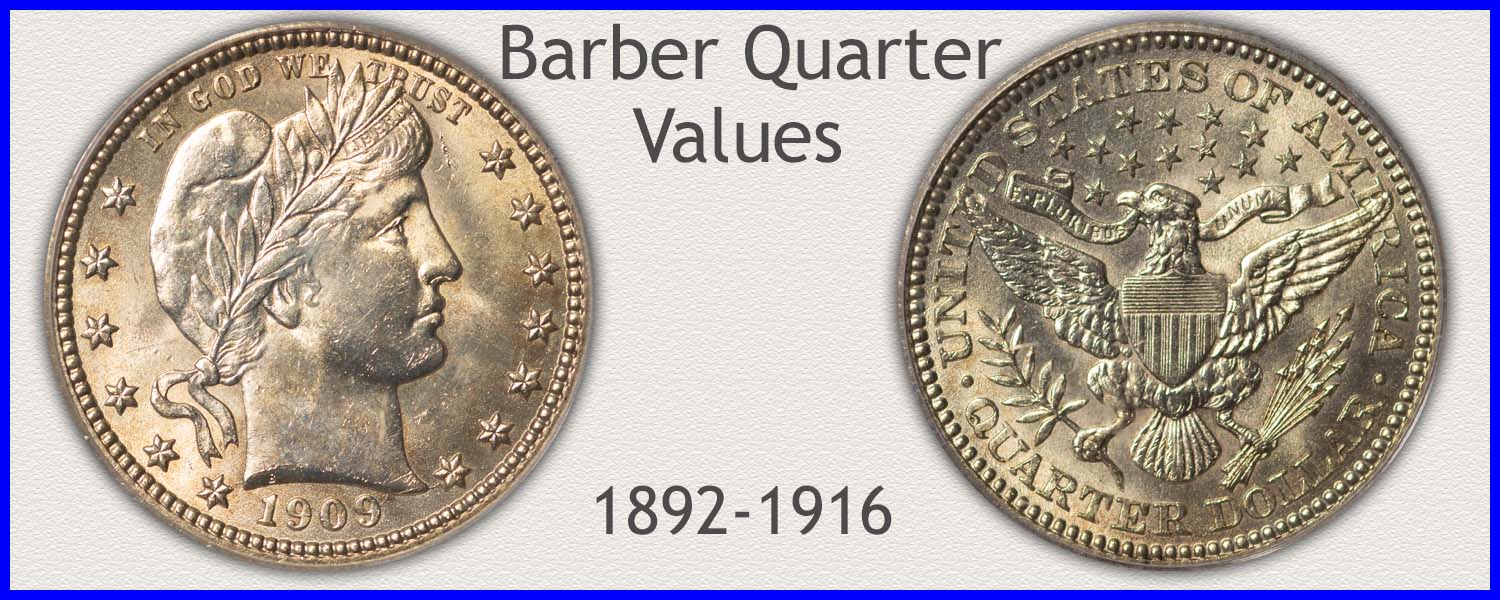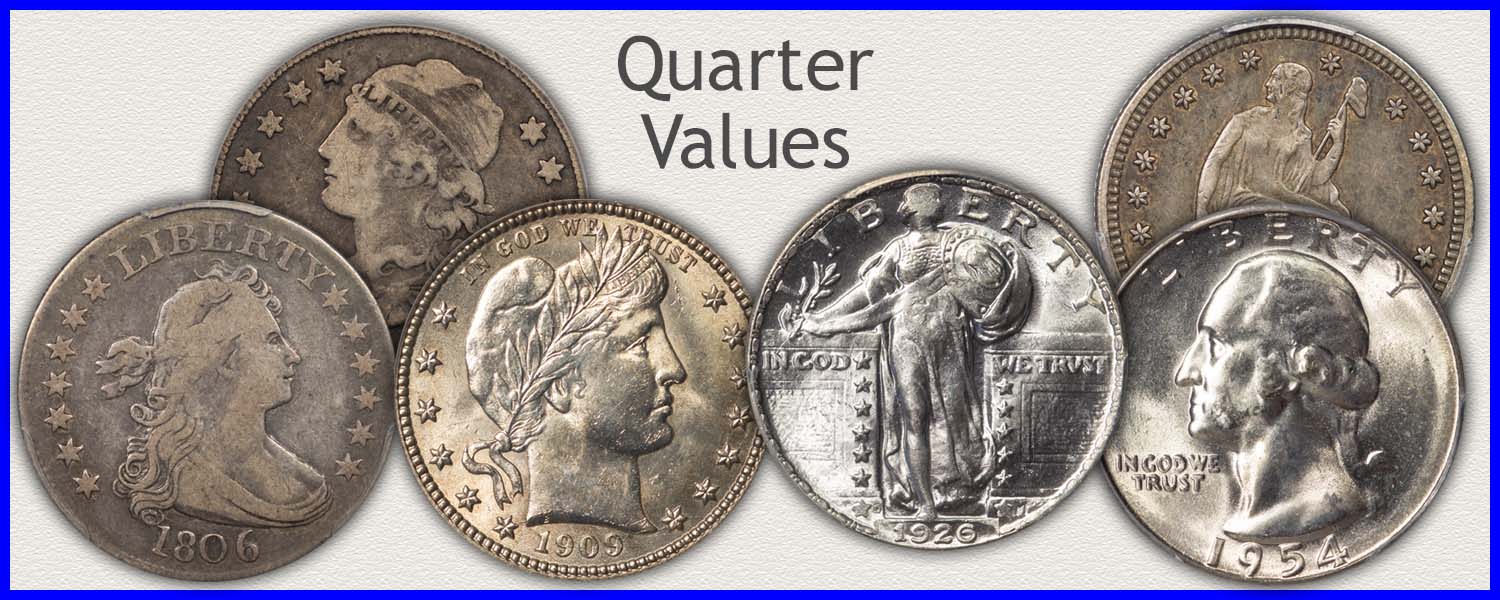Coin Values Moving with Precious Metals: Up-Dated 12/8/2025: Gold $4212 | Silver $58.12
1911 Quarter Value
With low remaining numbers, 1911 quarter value is at least $14.03 .
A majority of the quarters produced in 1911, which was a relatively small amount, became heavily worn over time due to circulation. When comparing images of coins in different grades of condition, a premium coin is recognized. The steps in a defined process confirms the date, the mint variety, condition, and special qualities as part of the Barber quarters series.
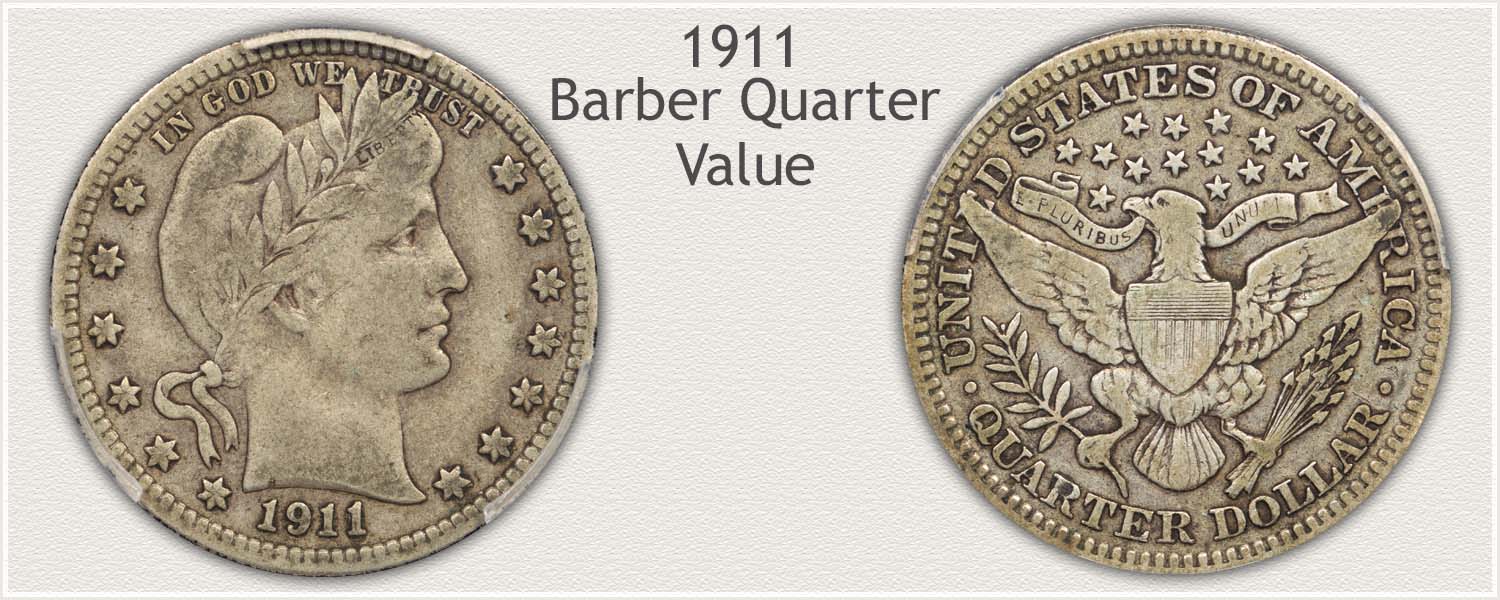
Steps Leading to Value:
- Step 1: Date and Mintmark Variety - In order to distinguish the scarce mint variety, a careful examination is required. The 1911 quarter's mintmark identifies the mint that produced the coin.
- Step 2: Grading Condition - A careful match between your Barber Quarter and the grading images narrows the range of values on the chart.
- Step 3: Special Qualities - Recognize the challenging date and mint combinations that are part of the elusive Barber quarters series and its varieties.
| 1911 Quarter Value | ||||
|---|---|---|---|---|
| Condition of Coin | ||||
| Date | Good | Fine | Extremely Fine | Mint State |
| Barber Quarter Values Updated | 12/8/2025 | |||
| 1911 | $14.03 | $21 | $71 | $221 |
| 1911 D | $20 | $89 | $255 | Rare |
| 1911 S | $16.15 | $96 | $287 | $414 |
Values listed are a starting point to wholesale Barber quarters. Dealer demands plus a close eye on condition are important to recognize. Use the steps to narrow the value range.
Step 1: | Confirm Date and Mintmark Varieties
Mintmarks on 1911 Quarters to Identify
Due to the moderate number of coins struck at the Philadelphia mint in 1911, theses have become a nice, available, example of this older series. The branch mint issues of quarters from San Francisco and New Orleans are less common.
Each of the branch mints issuing coins is recognized by their different mintmarks. The images below are used to locate and verify these mintmarks.
1911-S Barber Quarter
"S" Mintmark on Reverse: San Francisco Mint Struck the Coin
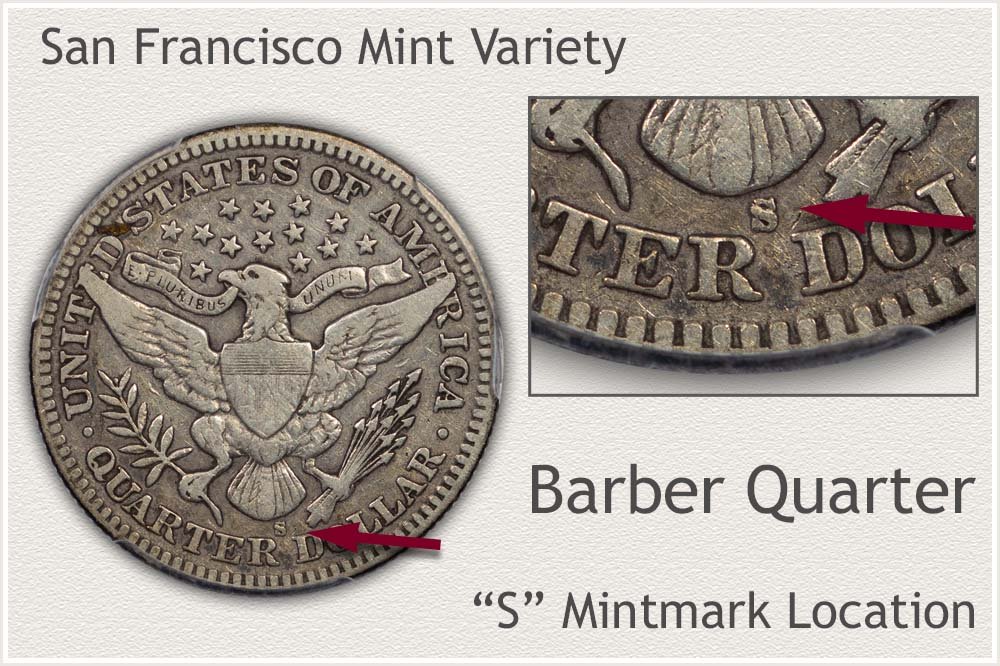
Drawing the attention of collectors, is the low mintage of the 1911 San Francisco quarter. Just 988,000 were produced. Any twentieth century coin from a vintage series with fewer than one million struck, is noteworthy. Most circulated to a very worn state.
Here is a low mintage coin, 90% silver in composition, with steady demand from collectors. Grading condition has become an important factor in a judgment of worth.
Confirm the San Francisco mint issues by the large "S" mintmark on the reverse. Above the lettering of "Quarter Dollar" and directly below the eagle's tail feathers is the mintmark location. A single large "S" identifies the coin was struck at the San Francisco mint.
1911-D Barber Quarter
"D" Mintmark on Reverse: Denver Mint Struck the Coin
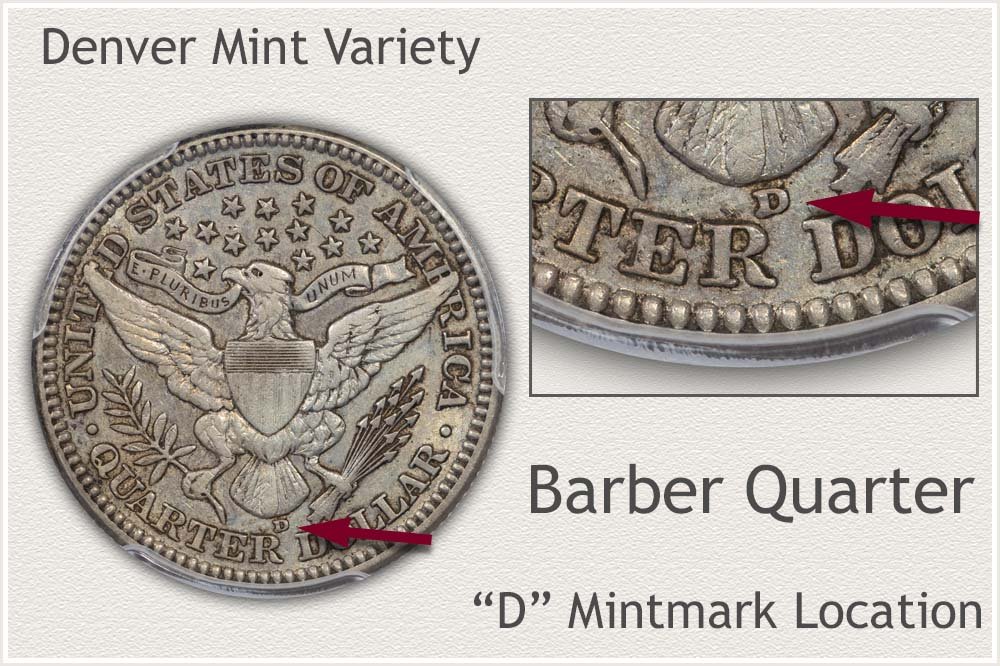
A significant quarter to collectors today was minted by the Denver mint in 1911. Low quantities were produced and few saved over the years, resulting in a scarce coin in all states of preservation. Mint records show just 933,600 struck by Denver and any production of twentieth century coinage under one million draws the attention of collectors. Their demand is a strong collectible support, far above basic silver worth.
Recognize these premium quarters by the large "D" mintmark found on the reverse. In the area below the tail feathers of the eagle and the lettering of "Quarter Dollar" is the "D" mark confirming the Denver mint variety.
1911 Barber Quarter
No Mintmark on Reverse: Philadelphia Mint Struck the Coin
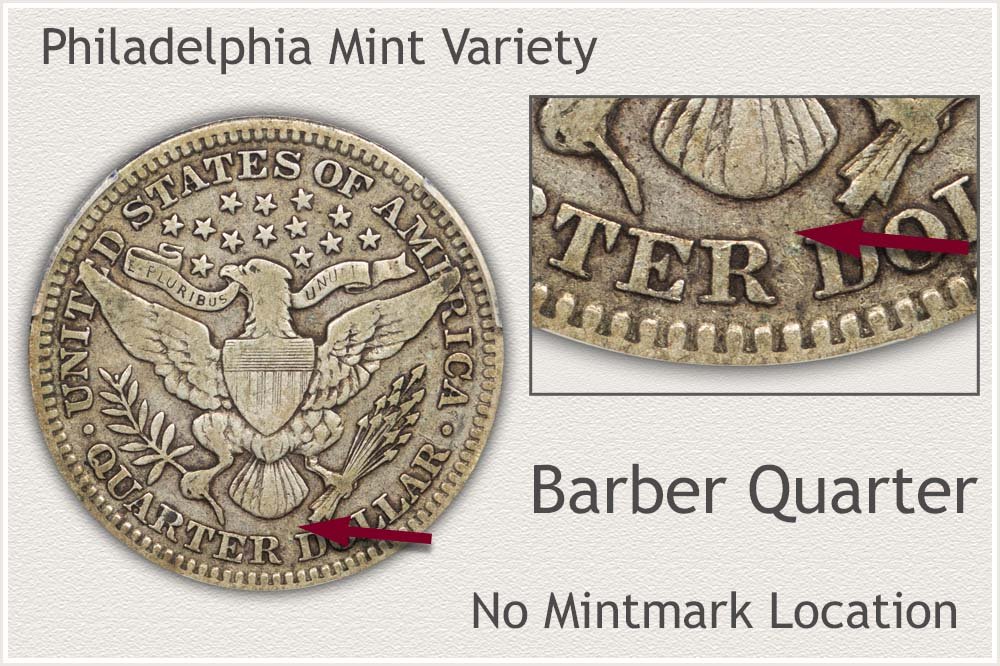
1911 Philadelphia mint quarters start with a value tied closely to their underlying silver worth. All Barber quarters are a 90% silver alloy. Coins in very worn condition are abundant to the point where the majority trade based on the price of silver.
Mintage total of Philadelphia 1911 quarters is recorded at just over 3.7 million pieces. A slightly lower amount than usual for Philadelphia. The majority of these served in circulation for a long time becoming very worn. A collector quality and premium example is one with pleasing detail remaining. The chart notes it takes a Fine grade or nicer example to rise into collectible status.
Collected by date and mint combination, each quarter is inspected for the presence or absence of a mintmark. Philadelphia coinage is identified by the lack of any mintmark. Inspect the reverse, over the lettering of "Quarter Dollar" if the space is empty, it is the Philadelphia mint variety.
Step 2: | Grades are Descriptions Used by Collectors to Define Condition
Subtle Condition Points Determine 1911 Quarter Value
The level of wear on coins is recognized and classified into distinct stages. As high points of the design are removed, the design changes significantly overall. It is possible to identify different grades based on these visual changes.
Starting with a coin that is in mint condition reveals all the original details that was present on the piece when it was initially produced. To assign a grade, compare to the images displaying various levels of wear.
Mint State Grade
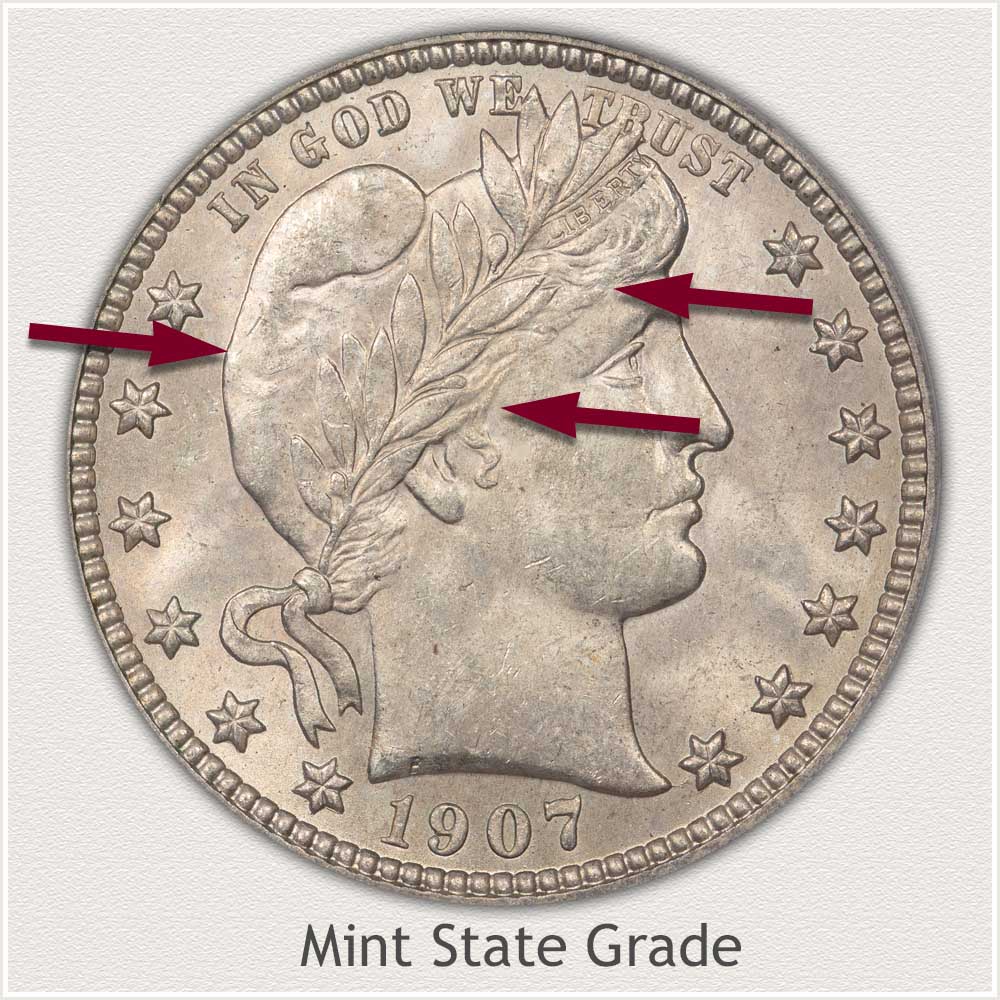
Mint State: For a quarter to qualify in Mint State grade, its surface must not show any signs of wear. When initially minted, these quarters feature a surface texture of fine grains, giving them a striking brightness. A tilted and rotated coin with this original texture reflects light as rotating luster.
High areas of the design are examined for signs of wear, smoothing, dulling, and flattening in order to judge whether this delicate luster remains intact. The cap on Liberty's head is one feature of the coin that wears and smooths out quickly in circulation. The upper edges along the cap are also examined, luster is still present and the metal remains textured. When silver becomes worn, it turns a soft gray color, very different from the original brilliance.
In addition, confirm fine lines to Liberty's hair above her forehead are full with no smoothing or blending. The very high relief area is the first to receive wear: note the complete separation of hair strands on the example quarter.
Extremely Fine Grade
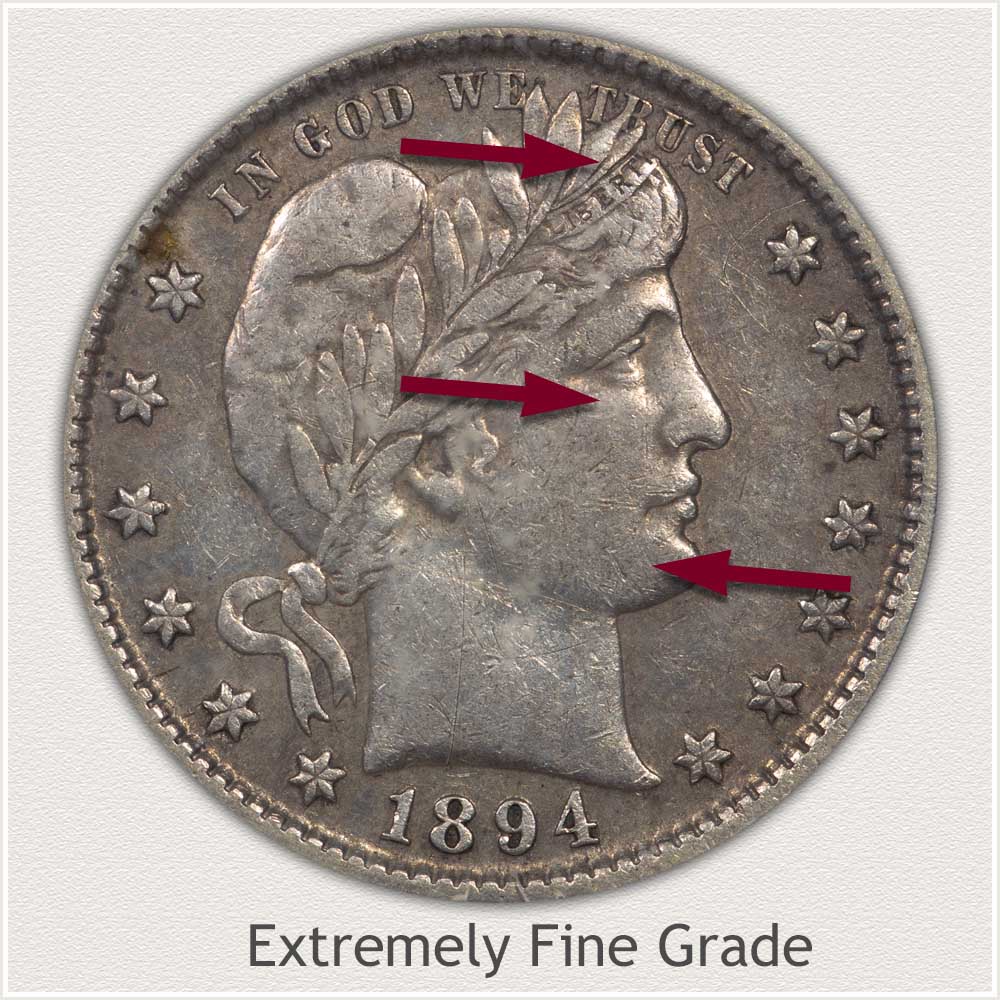
Extremely Fine: This quarter is a high-quality collectible since it retains many of its fine details in crisp and sharp condition. At the very tops of the design, only a slight loss of metal is visible due to light wear. An Extremely Fine grade is likely a good fit with the coin's state of preservation.
Inspect the lettering of "LIBERTY" within the headband, helping to judge condition. It is important to confirm the letters are complete and remain deeply impressed. The "Y" at the very top of her forehead is clear.
Luster that once covered the cheeks and jawline of Liberty's face has been worn away. A rounded contour however does remain along Liberty's jaw line to her neck. Metal flattening from wear is minimal and barely noticeable.
A sharply defined Barber quarter is a desirable and valuable collectible.
Fine Grade
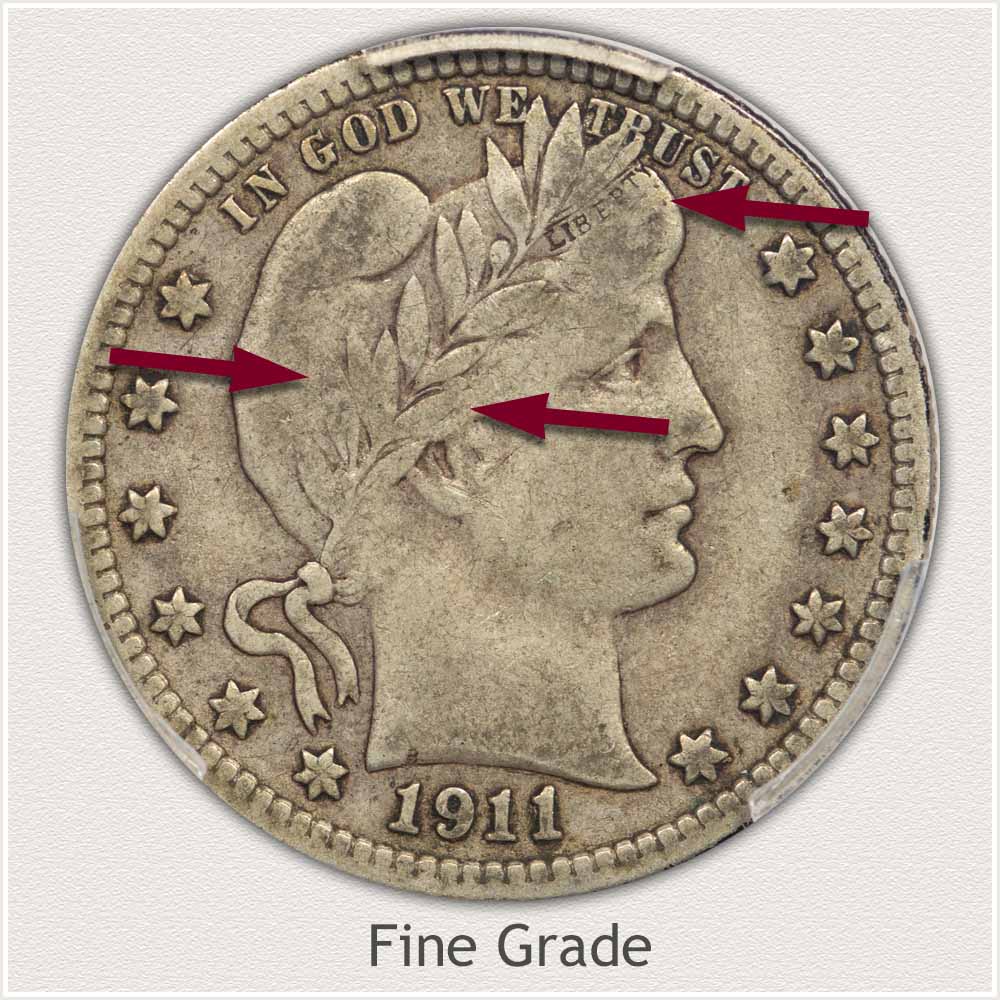
Fine Grade: A Fine grade quarter is defined by moderate wear, flattening, and merging of small design details. Focus on the lettering within the headband, the remaining detail in the wreath, and the metal's overall flatness to identify this condition.
Liberty's hair is adorned with a laurel wreath. Upper row of leaves, while smooth and flat, are well outlined and distinct from her hair, helping identify the Fine grade. Lower leaves are less distinct; many of them merge into the hair at the very ends.
Letters of "LIBERTY" is readable in full across the band that is placed atop her head. A prominent "BE" in the center is an excellent indicator of the Fine quality grade.
A slight flattening is visible on the contours of Liberty's portrait from an overall perspective. Inspecting the stars along the rim reveals a flattening of the metal, with the loss of the central radial lines; nevertheless, each star stands out prominently from the field. Remaining detail on these collectible condition quarters is substantial.
Good Grade
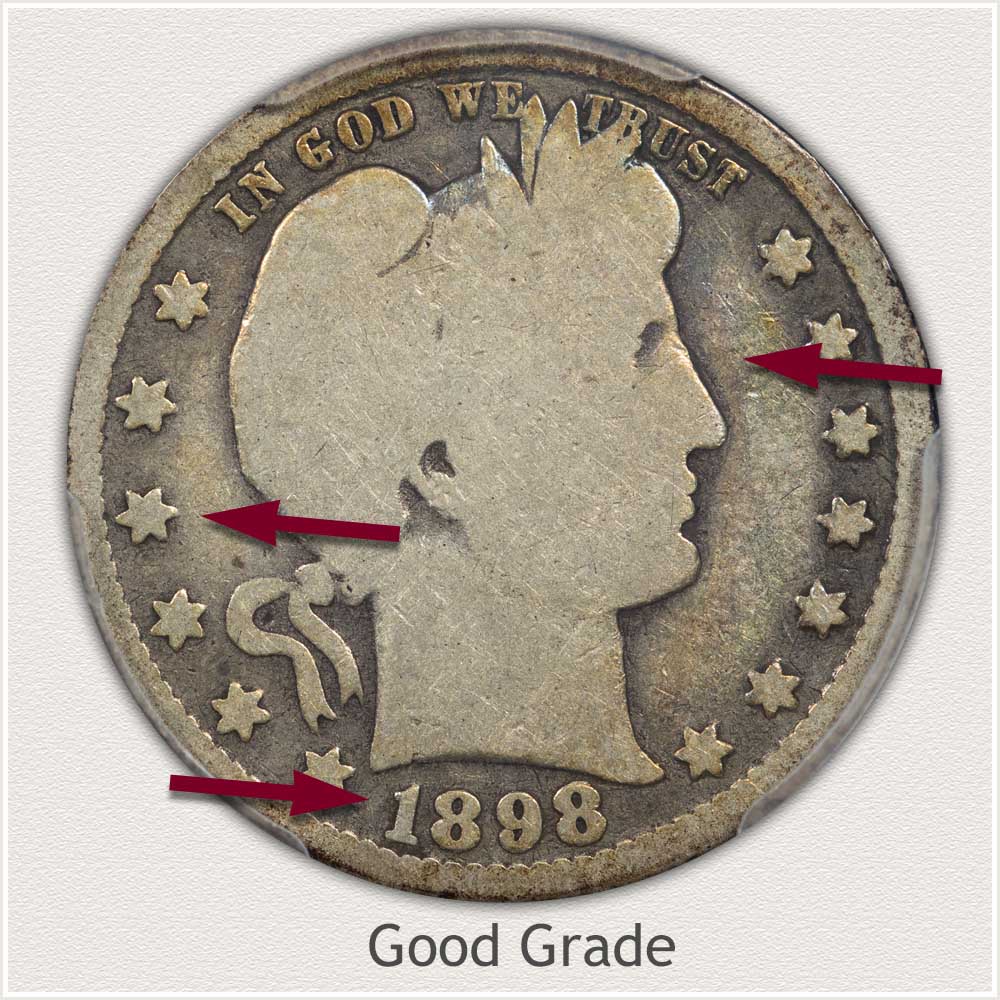
Good Grade: A strong appearance of Liberty's portrait contributes to the Good grade. A majority of the design's original elements are smooth. However, placing the example well within the grade is the fact her portrait does not fade into the coin's lower fields.
Remaining details are very crisp despite the extensive metal and design wear. Stars along the rim are clearly separated from the edge. Notice the rim's edge is a sharp line with no fading into the field, and nicely defined. With a prominent date, these coins have a pleasing appearance.
When looking at the surface as a whole, note an absence of blemishes and pleasing silver-gray hue with darker tones near the edges. A nice appearance for a well-worn Barber quarter.
How to Video: Grading Barber Quarters
There are several elements to evaluate when judging a Barber quarter. These features help judge and determine the degree of wear and surface condition. Specific grading components are highlighted in the video and descriptions.
Video, Images and Descriptions | Grading Barber Quarters
Step 3: | Special Qualities | Scarce Mint Variety
1911 A Special Year in Denver Mint Production and Challenge to Collectors
Barber quarters, as a series, are challenging to assemble into a complete collection featuring all date and mint combinations. A full set of these quarters is one of the major goals of collectors. Within the series, there are many common dates mixed with scarce varieties and a few rare date and mint combinations. 1911 Denver quarters span both the scarce and rare categories.
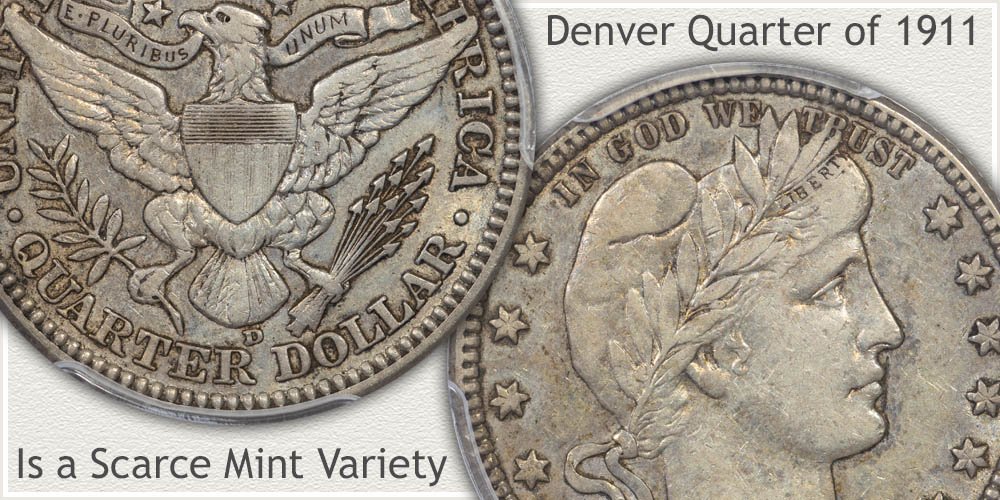
Denver struck the fewest number of quarters of the series in 1911, an immediate alert to collectors. What became known over the years was the lack of suitable examples in any state of preservation. Well-worn pieces are affordable, however, with improvements in condition and fine details remaining, values rise quickly. These nice, eye-appealing, circulated quarters are termed as Semi-Keys by the collecting community. All nice 1911 Denver quarters are scarce.
Mint State Grade 1911 Denver quarters are in a class by themselves. They are a Key to the series, a challenge to obtain, and highly valued. Mint state examples trade so infrequently each is assessed on its merits of preservation and are often bid to over one thousand dollars at auction. Multi-year auction records show few pricing examples.
A careful inspection of 1911-D quarters is needed to realize their true special qualities and value potential. Even the detection of a few letters of "LIBERTY" in the headband of the portrait equates to many times an increase in how much its worth.
References
U.S. Mint. 1912 U.S. Mint Annual Report
https://nnp.wustl.edu/library/book/324
U.S. Mint. Catalogue of Coins of the United States.
https://nnp.wustl.edu/library/book/554591
Coin Values | CoinStudy Articles
Date by Date
In Depth Barber Quarter Values
1892 to 1916
Barber Quarter Value | Many In Demand Dates
Different condition coins are valued separately, also the many dates and mints of the Barber quarters range from common to scarce to very rare. Complete value chart of all dates and mints with condition ranges are listed. All dates of the series are in demand.
Quarter Values | Discover the Many Varieties
Major design changes took place often in U.S. quarter coinage. Images help identify your old quarter along with links to the different series. Value charts list Bust, Seated, Walking Liberty, and Franklin half dollars.
Old Coin Values | Step by Step Process
Collectors and dealers follow specific steps when placing values on coins. Use the same method to value your coins. Dates and mints are identified. Different design series are imaged along with images of the grades important to accuracy. An introduction to coin values step-by-step.
Print the Coin Values Worksheet
Record accurate descriptions of Barber quarters with values. Your collection becomes identified and organized.
Silver Coin Values | Minimum Values of U.S. Silver Coins
Silver was a base metal to U.S. coinage up to 1964. Many of these silver dimes, quarters, halves, and silver dollars are valued and traded today rising and falling with the price of silver. Using the calculator and current market price of silver determine the minimum worth of the older 90% silver coinage.
Rare Quarters | Spanning the Many Series
Many Barber quarters are entering the scarce to rare value range. Those of the 1890's are difficult to find in nice condition. All series of quarters are reviewed, pointing to the scarce and rare qualities placing these old coins high in value.
Selling Coins | Organized and Planned
Organize and record key factors to your coins to begin the selling process. An understanding of current market values with an accurate description of the coin, helps find the right buyer. Follow the same process use by the coin collecting community.
★Coin Values Discovery finds 1911 Quarter Value and...
All old U.S. coin values. The home page Introduces the important steps in the value process. Identifying your coin series, accurate date and mint, and images to compare when judging condition. Key elements are noted to narrow a range of how much these old coins are worth.
